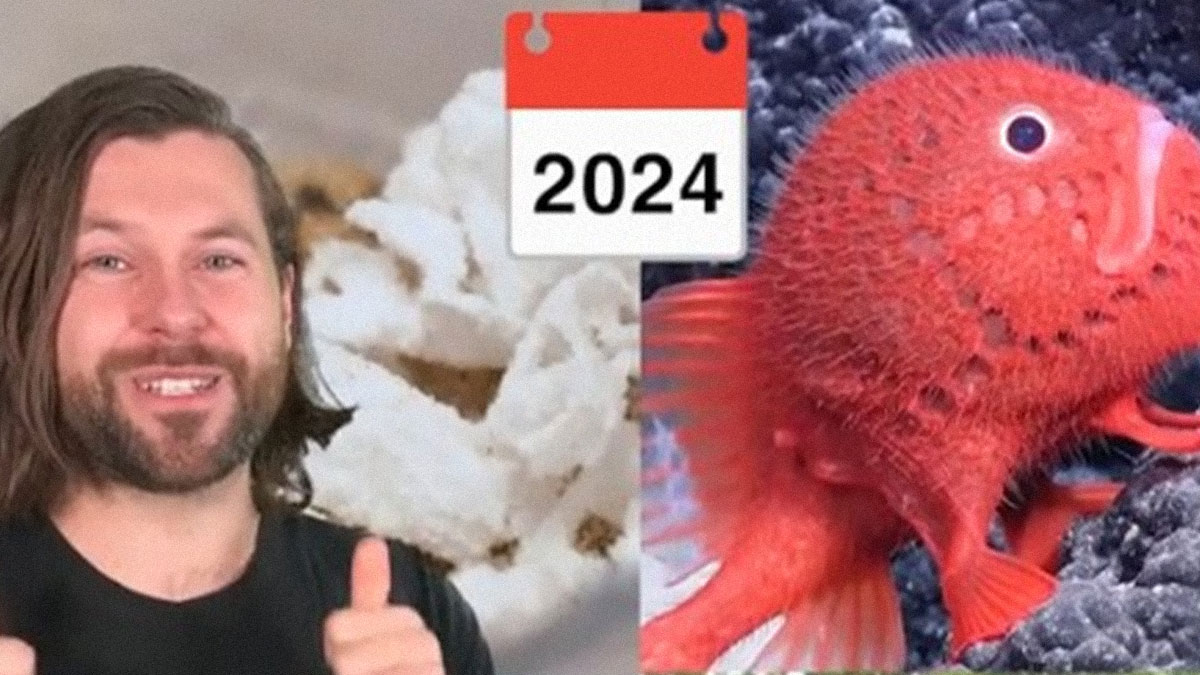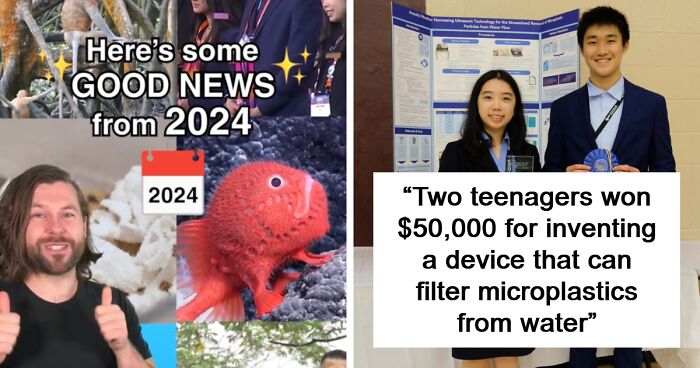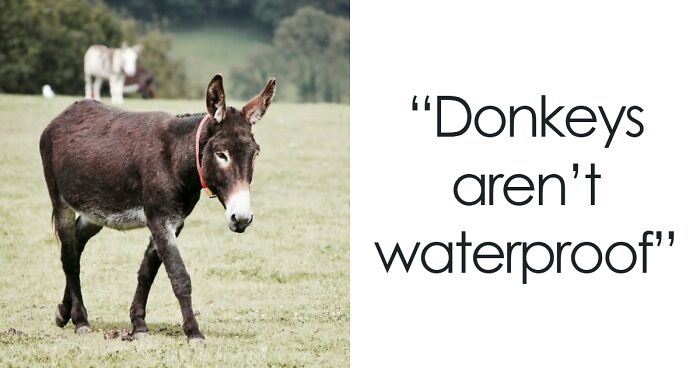
12 Of The Most Uplifting Pieces Of News From 2024 For Those Who Are Fed Up With The Bad News
The internet is abundant with so much negativity that we end up overlooking the uplifting news pieces. Thankfully, we have content creators to remind us that not everything you read about online covers the doom and gloom of the world.
TikTok user Sam Bentley is one of them. One of his recent posts is a rundown of some of the positive things that happened in 2024 that mainstream media failed to bring to light.
These events could restore your faith in humanity or, at the very least, make you feel more optimistic about the future. Enjoy scrolling through.

Image credits: sambentley
This post may include affiliate links.
Kenya's Black Rhinos That Nearly Went Extinct Made A Huge Comeback And Doubled In Number To 1,000
Weird thing I remembered as a kid-white rhino's have wide mouths and the black rhino's have narrow ones. REALLY damned happy the fleshy tanks are coming back
Two Teenagers Won $50,000 For Inventing A Device That Can Filter Microplastics From Water
20 Indigenous Groups In The Peruvian Amazon Managed To Secure Land Rights To Over 75,000 Acres. It's Three Times As Big As Manhattan!
Well, considering the entire Amazon rainforest is 71% the size of the entire US, including Alaska and Hawaii, while it's progress (and to be applauded), it's not huge progress. Indigenous people used to be all over the Amazon basin.
Have you ever wondered why most media outlets cover more of the grim aspects of society than those that bring more positivity to the world? According to Dr. Rasmus Kleis Nielsen, Director of Research at the Reuters Institute for the Study of Journalism at the University of Oxford, it is all by design.
In an interview with the university, Dr. Nielsen explained that a journalist’s primary objective is to “de-mask” powerful institutions and individuals and hold them to account.
Seven Countries Now Generate Over 99% Of Electricity From Renewable Sources
The Largest Dam Removal In Us History Was Completed, Opening Up 400 Miles Of The Klamath River, Helping Salmon And Communities That Rely On The River To Thrive
The removal of dams over the last decade or so in the USA has been HUGE.
Pakistan Tripled Their Mangrove Forests Over The Last 30 Years
Another reason reporters focus on negativity is that they are more drawn to events than trends. According to Dr. Nielsen, this approach tends to conceal the truth of the situation in its entirety.
However, focusing on adverse events that have particular consequences for named individuals creates a human-interest story, which is good for business.
Scientists In Singapore Discovered Superworms That Can Digest Plastic Thanks To Their Gut Bacteria
Their poop doesn't cause super-alzheimers or something like that once it's in our food chain? This is good news because they ALSO tested the poop, and it's just safe old worm poop, right?
Greece And Sweden Became The First Countries In Europe To Announce Bans On Bottom Trawling To Help Protect Our Beautiful Ocean
Uruguay Ran On 100% Renewables For 10 Months Straight
It can be done, it involves using less resources, and causes less damage to the environment and yet people complain about it.
Of course, overconsuming the toxicity on the internet can affect our mood and mental health. That’s why Boston University researcher and marketing professor Carey Morewedge emphasizes the importance of balanced reporting.
“In the long term, these sites may be better suited by providing more of a mix of positive info,” Morewedge told Vox in a 2023 interview. “Just thinking about what people do in the present may not capture their full preferences.”
Japanese Researchers Developed A Revolutionary Biodegradable Plastic That Dissolves In Seawater And Doesn't Generate Microplastics
Okay but stuff can't just dissappear, so does it dissolve into something that microscopic ocean animals eat?
I'm guessing it dissolves into nearly harmless monomers like ethylene. (That's not great for greenhouse gasses, but it'd be a tiny amount compared to fossil fuel usage.)
Load More Replies...Sounds too good to be true. I hope they test the long term impact well before it gets sold to millions.
Yeah but the idea is that we do not put plastic into the sea at all.....
But what will it do to the seawater??? So they are just going to dump more plastic into the oceans?
India Electrified Over 94% Of Its Railways, And 45% Of The Electrification Happened In Just Five Years
Scientists Discovered Almost 100 New Deep-Sea Species Living Up To 14,000 Feet Under The Sea
Bentley's video below is a breath of fresh air from the gloominess that’s become prevalent on social media timelines. As expected, people in the comments appreciated his focus shift.
@sambentley Some of the best good news from 2024 you may have missed! #fyp #foryou #goodnews #sustainableliving #conservation #newstiktok ♬ original sound - Sam Bentley
















We need to celebrate scientists and green thinkers more. Less of the vacuous celebrities and the idiotic billionaires with God complexes.
There's a YouTube video of Carl Segan explains climate in Congress. Called him woke, fake news. Even Margaret Thatcher spoke at the UN on climate change and the social consequences. Carl: https://youtu.be/Wp-WiNXH6hI?si=gP1c6PgpV80MF2fJ Margaret: https://youtu.be/VnAzoDtwCBg?si=65HgPxnPyY-O39Gp
Load More Replies...Being pessimistic perhaps, but only 12 good news? 😅 and at the same time "100 [unwanted] celebrity news". Also BP, where is my notifications now? Is this a premium option only? 👋
Just found them! Using Windows here. But are there on Android Chrome as well! 😮 Notificati...06-png.jpg 
BP used to be almost all positive posts like this. It has gradually turned into a tabloid and has more and more garbage posts every day.
Load More Replies...Trump will soon dismantle any eco-friendly initiatives the day he takes office here in the lousy USA...he is a pig...
For more good news, i check Goodnewsnetwork.org and sunnyskyz.com everyday, otherwise the doomscrolling would drive me insane.
In one lifetime, India's life expectancy has increased so much that it's two lifetimes according to its previous life expectancy. (In 70 years, its life expectancy has grown from 35 to 71.) In fact, the larger part of global population growth outside Africa is not from birth rates exceeding replacement levels, but from the fact people are dying a lot less.
Everyone dies eventually. People should have fewer kids.
Load More Replies...Way too many negative comments on nearly every entry. People will really find reasons to be miserable won't they?
We are in an environmental crisis the likes of which humans have never seen before. It's only good news if it actually makes a REAL difference. We know there are inventions that never go anywhere because big corporations have ways of shutting things down that don't benefit them. And it's good to ask questions like, with the plastic-eating worms, you can't accept that as great without asking questions about it. That's not being negative, it's being realistic, and being realistic for that kind of discovery or advancement is the only responsible reaction.
Load More Replies...We need to celebrate scientists and green thinkers more. Less of the vacuous celebrities and the idiotic billionaires with God complexes.
There's a YouTube video of Carl Segan explains climate in Congress. Called him woke, fake news. Even Margaret Thatcher spoke at the UN on climate change and the social consequences. Carl: https://youtu.be/Wp-WiNXH6hI?si=gP1c6PgpV80MF2fJ Margaret: https://youtu.be/VnAzoDtwCBg?si=65HgPxnPyY-O39Gp
Load More Replies...Being pessimistic perhaps, but only 12 good news? 😅 and at the same time "100 [unwanted] celebrity news". Also BP, where is my notifications now? Is this a premium option only? 👋
Just found them! Using Windows here. But are there on Android Chrome as well! 😮 Notificati...06-png.jpg 
BP used to be almost all positive posts like this. It has gradually turned into a tabloid and has more and more garbage posts every day.
Load More Replies...Trump will soon dismantle any eco-friendly initiatives the day he takes office here in the lousy USA...he is a pig...
For more good news, i check Goodnewsnetwork.org and sunnyskyz.com everyday, otherwise the doomscrolling would drive me insane.
In one lifetime, India's life expectancy has increased so much that it's two lifetimes according to its previous life expectancy. (In 70 years, its life expectancy has grown from 35 to 71.) In fact, the larger part of global population growth outside Africa is not from birth rates exceeding replacement levels, but from the fact people are dying a lot less.
Everyone dies eventually. People should have fewer kids.
Load More Replies...Way too many negative comments on nearly every entry. People will really find reasons to be miserable won't they?
We are in an environmental crisis the likes of which humans have never seen before. It's only good news if it actually makes a REAL difference. We know there are inventions that never go anywhere because big corporations have ways of shutting things down that don't benefit them. And it's good to ask questions like, with the plastic-eating worms, you can't accept that as great without asking questions about it. That's not being negative, it's being realistic, and being realistic for that kind of discovery or advancement is the only responsible reaction.
Load More Replies...
 Dark Mode
Dark Mode 

 No fees, cancel anytime
No fees, cancel anytime 









































![“AITA For Losing [It] And Screaming At GF To Get Out Of My House After What Her Stepbrother Did?”](https://www.boredpanda.com/blog/wp-content/uploads/2025/01/man-screams-gf-over-creepy-stepbrother-fb18-png__700.jpg)






